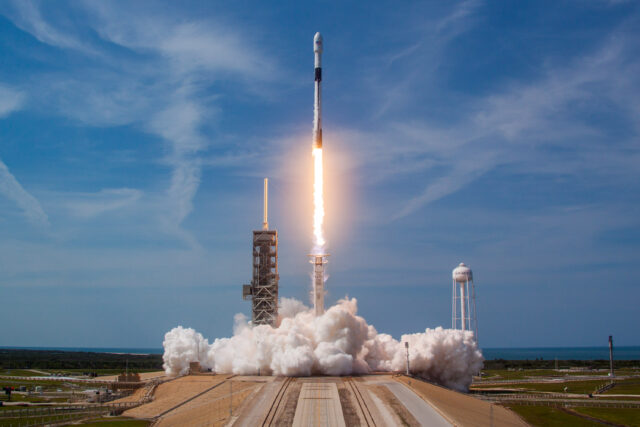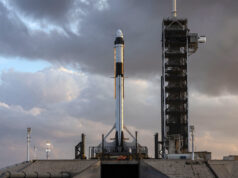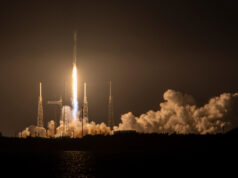
The predawn sky over Florida lit up on Monday, April 21, 2025, as a SpaceX Falcon 9 rocket clawed its way into orbit from Launch Complex 39A at NASA’s Kennedy Space Center. Strapped atop the booster was a familiar sight: a Cargo Dragon spacecraft, beginning its journey to the International Space Station (ISS). This flight marks SpaceX’s 32nd resupply mission for NASA, a seemingly routine event in the era of commercial spaceflight. Yet, nestled within the Dragon’s cargo hold are vital supplies and groundbreaking scientific experiments that carry profound implications for humanity’s push deeper into the cosmos and improving life right here on Earth.
The Falcon 9 lifted off precisely at 4:15 a.m. EDT, a picture of power and precision. Just over eight minutes later, the rocket’s first stage, a veteran booster making its third flight and landing, settled gently onto Landing Zone 1 at Cape Canaveral Space Force Station. This controlled touchdown highlights the reusability that has become a hallmark of SpaceX operations, a key factor in driving down the cost of accessing space. Meanwhile, the Cargo Dragon continued its climb towards the orbiting laboratory, carrying approximately 6,700 pounds of essential items and research payloads for the Expedition 73 crew.
The Dragon spacecraft, tail number C209, is no stranger to the vacuum of space; this mission marks its fifth trip to the ISS. Its capability to autonomously dock with the station streamlines operations for the crew aboard. The spacecraft is scheduled to link up with the zenith port of the Harmony module on Tuesday, April 22, around 8:20 a.m. EDT, delivering its precious cargo.
While food, water, and equipment form the backbone of any resupply mission, the scientific investigations aboard this Dragon flight truly capture the imagination. They represent crucial steps in understanding how life and materials behave in microgravity, knowledge essential for long-duration space travel and unlocking new possibilities on Earth.
One compelling experiment focuses on refining the maneuvers of free-floating robots. These autonomous helpers could become indispensable crewmates on future missions to the Moon and Mars, assisting with inspections, maintenance, and research, freeing up astronauts for more complex tasks. Imagine robots smoothly navigating future lunar habitats or Martian outposts, thanks to the testing happening hundreds of miles above us today.
Air quality is paramount for the health and safety of astronauts in a closed environment like the ISS or a future spacecraft traveling to distant worlds. This mission delivers an enhanced air quality monitoring system for testing. Learning how to accurately monitor and maintain breathable air far from Earth is critical for the success of extended human voyages. The findings from this research could also lead to improved air quality monitoring here on Earth, benefiting public health.
Precision timing plays an unsung hero role in space exploration and fundamental physics. Aboard the Dragon are two atomic clocks. These incredibly accurate timepieces will contribute to examining concepts of fundamental physics, like relativity, and testing the global synchronization of precision timekeeping devices. These experiments push the boundaries of our understanding of time and gravity, potentially leading to more accurate navigation systems for space and terrestrial applications.
The Dragon also carries investigations into the behavior of materials and biological processes in microgravity. One project studies protein clumping, a challenge in the manufacturing of certain pharmaceuticals. Understanding this process in space could lead to improved drug formulations and production methods on Earth. Another test evaluates different aerosol monitors, aiming to develop more reliable systems for detecting airborne particles, which has clear applications for both space habitats and terrestrial environments. Research into how tomato plants adapt to microgravity and whether supplements can boost their growth is also underway. This work is crucial for developing sustainable food sources for astronauts on long trips, and could offer insights for improving agriculture back home, particularly in challenging environments.
This CRS-32 mission takes on added significance as the station relies heavily on commercial partners for logistics. Recent challenges with another provider highlight the importance of SpaceX’s consistent ability to deliver vital supplies and research to the orbiting laboratory. It underscores the success of NASA’s strategy to partner with private industry to keep the ISS operating at its full potential.
The Cargo Dragon will remain docked to the ISS for approximately one month. During this time, the crew will unload the fresh cargo and fill the capsule with completed experiments, station hardware no longer needed, and waste. When its stay concludes, the Dragon will undock and perform a deorbit burn, re-entering Earth’s atmosphere. Unlike most cargo spacecraft which burn up upon reentry, the Dragon is designed to survive this fiery plunge, splashing down in the ocean off the coast of California. This capability allows NASA and researchers to quickly retrieve valuable scientific samples and equipment that have been exposed to the unique microgravity environment, providing a crucial link in the chain of space-based research.
Each launch, docking, and return of a Cargo Dragon represents more than just a delivery service. It’s a tangible connection between Earth and the outpost orbiting above us, a lifeline for the astronauts living and working there. It’s also a regular opportunity to send crucial experiments that promise to expand our scientific knowledge, develop new technologies, and provide practical benefits for people everywhere. This 32nd mission, like those before it, quietly but profoundly moves the needle forward for both space exploration and scientific discovery.










